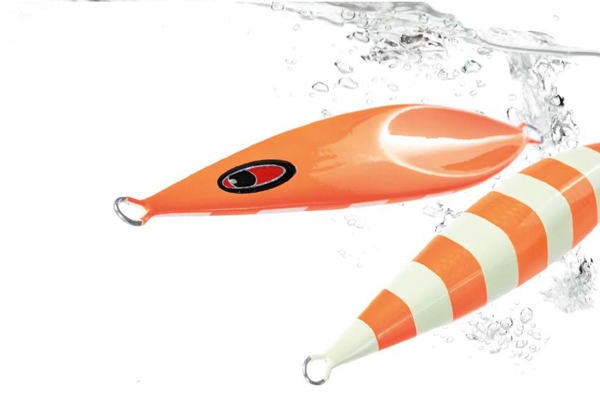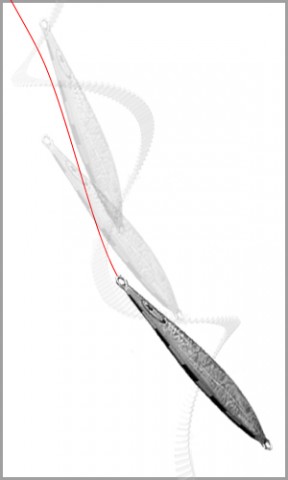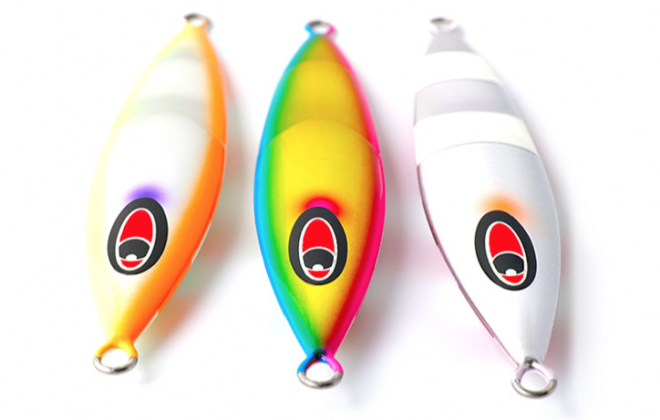Close look on jig movements
Each model of Seafloor Control jigs are born from hundreds of samples which are tested in different fields and for different targets. Also the designs need to be refined according to different weights too. When a new jig comes out, just couples of weights come available since other weights are still under review for refining.
Anyway, let’s take a close look into jig movements and see what characteristics each jigs can have.
Uplift
Some jigs feel light in uplift, some feel heavy, and some feel kind of “sticky”. According to the hydrodynamics, every jig feels different.
Rector, Spunky, Messiah, and Arc feel very light, meaning they are easy to follow your uplifting action and pick up speed for the next move.
Gawky feels heavy, meaning it catches much water-resistance. The water resistance tries to rotate the jig. Experienced anglers know, no matter what jigs you use, meal jig, soft lures, kabura, tenya, tai-rubber, the fish won’t be interested if the jig rotates. Gawky shape tries to avoid rotations with the keel along the center of the belly. Still, the angler should uplift Gawky slowly, using “rod to jig weight balance” in soft action tone.
Cranky and Abyss feel “sticky”, which means they follow the uplifting action well, but it doesn’t pick up much speed. Maybe it’s less effective in hydrodynamics than Rector and Spunky. Or maybe it creates more turbulence to pull it back. Gentle and low-profile movements.
Hangtime
You hold reeling, hold up the rod, letting the rod whip up to release the jig for free swim. This is when fish bites the most and it’s the most critical point in jig design. At this point, the jig changes its vertical position to horizontal. Some jigs are quick to lie on its side at the release, some make big curve to go the distance. Some carry greater momentum to go straight and longer than the others.
But if the jig moves too much, it twirls. It may look exciting and attractive to human eye, but this is the movement that fish hates, Sato Sensei says. If you are a fish chasing a bait, and if suddenly the bait quickly turns around and comes right back at you, you would go “Whoa!” and back off, right? The jig needs to be designed not to move too much at the release. Only few jig designers pay attention to such details, such as Seafloor Control and Deepliner.
Messiah goes the longest distance at the release after given great impact. Spunky follows the next. They are great in high pitch application. Arc seems slower to turn horizontal, making it more suitable in slow pitch application.
Rector turns horizontal in a curve for good hangtime. Cranky is very quick to turn horizontal but it doesn’t swim long. Abyss move is very smooth and soft to turn horizontal but also it can swim for long too when given big impact. Gawky doesn’t really hang. It turns horizontal then it starts falling right away.
Free Fall
When the jig loses the momentum, it starts falling. The center-balanced jig falls on its belly and catches different kinds of hydrodynamics to move differently. This is typically the time to attract fish.
Messiah is the fastest to fall in its nature. Messiah swims for a long way. After a long swim, it keeps the momentum and does interesting slow fall moves. Often Messiah swims for so long that it hits the end of line slack, swings the tail to the opposite direction, hover and fall. You hardly get a bite in the later part of plain free fall, but a lot of bites on the early part of free fall. (Maybe it’s a part of hangtime) Spunky is like that too.
Rector is the slowest to fall and that is why it’s so effective. The spoon-shape tail does the trick, making it fall and swing like a falling leaf. Abyss hovers and falls slow too when free fall. (But it changes the behavior when a little tension is given to the line.) Rector and Abyss are quick to turn horizontal on the fall. When you are in much water resistance and your rod can’t kick up, don’t worry, you can just lift these jigs and drop. It falls tail first but right away it turns horizontal.
Arc is very effective in falling for a semi-long jig. It seems like the wobbling is just right as it falls in a rock or a spin. Cranky has various fall patterns. Sometimes wobbles to fall slow and sometimes falls like crazy. Personally I don’t find it very effective in fall. Gawky falls steady wobbling. It’s the most dependable jig for fall tactics.
Tensioned Fall
When you initially drop the jig to the bottom, the line has a little tension as the jig pulls the line out of the spool, and the water pushes the line away. Because of the line tension, the jig falls tail first, and fast. You can intensionally give this kind of tensioned fall after uplift action too. After a slow uplift, give a fast tensioned fall. This way you can make a change of pace, which can trigger your target to chase.
But keep in mind that, when you are in the heavy water, your jig falls already on the tensioned line. “Heavy water” means that your line is catching a lot of water, whether you are not vertical, deep, or in the multi-layered complex currents. In such a condition, don’t try to tensioned fall because the line is already tensioned. Remember, when the water is pushing the line a lot, the water may be even lifting the jig when you think it’s falling.
Messiah, Spunky, Abyss, Arc, Cranky are fast to fall and work great in heavy water situations. Abyss is very slow in free fall right after hangtime, but when given tension, it falls right down. The change of pace is radical, and that’s the fun part of this jig.
Gawky is not so fast. But it seems that Gawky is able to stay more horizontal against the line tension. Also you usually use heavier weight than other jigs to play in soft action tone. So the fall speed wouldn’t be an issue usually.
Rector is slow to fall because it swings and rocks. If you use Rector in a great water resistance, use much much heavier weight and use long fall application.
Related Posts
4 Comments
Leave a Reply Cancel reply
Categories
- 1. SPJ (57)
- 1-1. Principles (9)
- 1-2. Techniques (11)
- 1-3. Setup (17)
- 1-4. FAQ (19)
- 1-5. Tackles (3)
- 1-6. Video Gallery (2)
- 2. Other Offshore Games (5)
- 3. Fishing Report (105)
- 3-1. Totos (25)
- 3-2. Readers (72)
- 4. Fish Cooking (19)
- 4-1. Iki-Jime (3)
- 4-2. The Art of Sashimi (5)
- 4-3. Recipe (7)
- 4-4. Seasoning (3)
- 5. Fishing Charter (6)
- Fish (12)










G’day mate , I was interested to know what you think of shimano butterfly jigs ? Would you class them as slow jigs ?
I am looking for a jig to use for snapper in 30 to 60m of water , any suggestions?
Shimano launched butterfly jigging system was well prepared and came out just before slow pitch jigging. And slow pitch jigging really ruined Shimano’s new project. SPJ was so effective and became so popular, so fast, that nobody paid attention to butterfly jigging. No, it’s not a slow pitch jig.
I just bought some deep liner jigs , a cx and vb jigs , can you recommend correct actions for these jigs ? Fishing 45 to 60 m got snapper / kingfish ?
CX and VB are both for standard slow pitch actions. VB is not good in the fast current. VB when the current is loose. CX is pretty versatile.
Good luck.